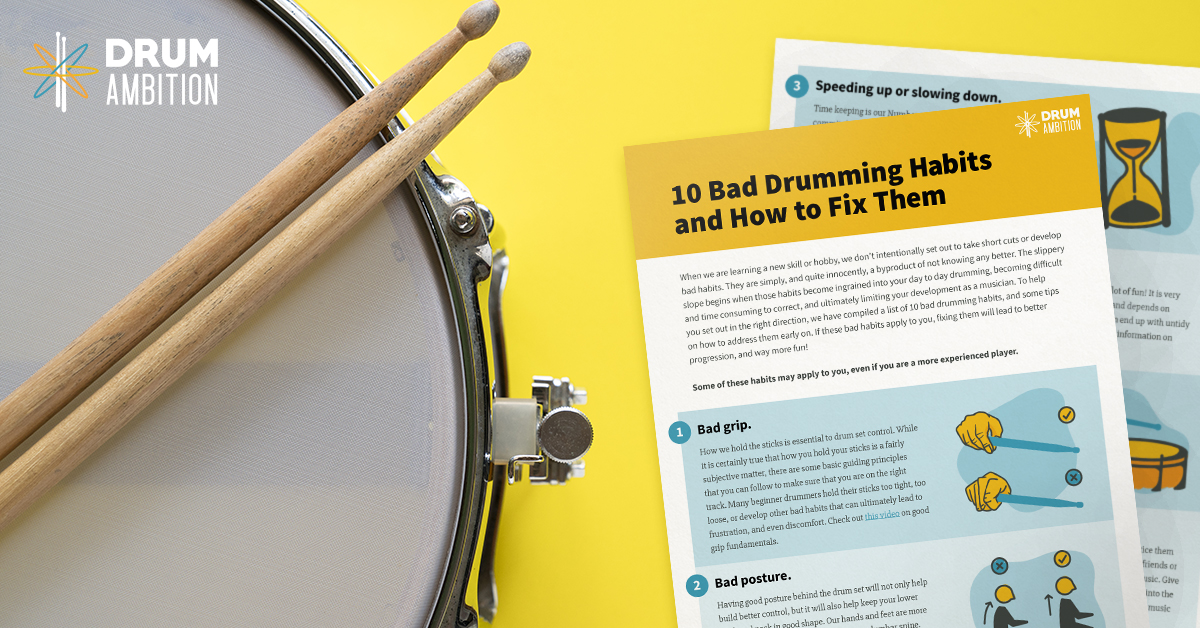In your early drum lessons, you will soon learn that having good technique can prolong the life of your drum sticks. It can be an inconvenient and costly affair if you regularly break them. Drum sticks are considered consumables because they need to be replaced at somewhat regular intervals.
With the average cost of a pair of drum sticks being around $10, it's certainly not something we should let happen too often. Some common scenarios lead to frequent breakage. Some are technique-based, and some are just a natural result of playing your drums and cymbals. To see if you are a candidate for regular unnecessary stick replacement, we have compiled five questions for you and thrown in some useful tips.
Helpful related articles:
Which drum sticks should I use?
Drum stick selection - 5 Essential Facts.
1. Have you selected an appropriate stick?
The old saying "you get what you pay for" is certainly applicable when selecting your drum sticks. The established brand names are likely to offer a better quality product, state-of-the-art manufacturing, and superior grade wood. Brands like Vic Firth, Vater, Regal Tip, Zildjian, and ProMark are trusted manufacturers, using the latest technologies and premium materials to make their products. The majority of sticks made by these brands comprise of select hickory, oak, and maple. They are more likely to outlast the bargain bucket, nondescript sticks that you can find in your general music store. Drum sticks are classified in different weights, with the average weight being a 5A. Our blog on stick selection can help you select what's right for you.
2. How is your technique?
If you have not spent time developing your technique, then you are more likely to break sticks. This is true regardless of which brand of sticks you use or the quality of the design and build. If you are holding your drum sticks too tight (using the so-called death grip), you will break them often. As you will discover in our videos, holding the stick in a relaxed but controlled way contributes to dynamic playing, speed, power, and endurance. These are all byproducts of control that are developed over time. This introductory video on grip shows you how to hold the sticks to build good technique and ensure your drum sticks' optimum life.
3. How are you striking your crash cymbals?
Many beginner drummers, who may still be developing their technique, often break their sticks when striking crash cymbals. Even when you have developed a good grip technique, you are causing stress on the sticks, cymbals, and wrist if you are striking your cymbals in a direct downward motion. In our videos, we show you how to safely and musically strike your cymbals using a glancing movement. This is the motion of striking your cymbal from right to left (or left to right in certain situations) in a downward motion, taking the pressure off the stick and cymbal. Not only will you preserve your sticks when doing this, but you will also spare your cymbals from cracks and your wrists from potential injury. Our subscribers can see this demonstrated in Module 1, Lesson 4.
4. What about rim-shots and hi-hat playing?
Even when you have good technique and an appropriate stick weight, certain aspects of playing the drums naturally fatigue the stick. For example, if you are regularly playing rim-shots, your stick's main body is being subjected to more wear and tear, and it is common to see fraying and shredding. If you are playing on the edge of your hi-hats with the shoulder of your stick, this will cause more stress than if you were playing with the tip of the stick on the top of the hi-hat cymbal. Given that you will want both of these musical options, stick fatigue will be inevitable over time.
5. Do you examine your drum sticks before you play?
It's always a good idea to take a look at your sticks before your start playing, make sure that there are no visible signs of damage, and ensure that the tips have not been chipped. The latter can lead to inadvertently pitting your drum heads, and the replacement costs can start to escalate. Pitted heads can affect the sound and eventually lead to a stress failure such as a tear or split. If you are using drum sticks with plastic tips, this is important. If these tips fail and detach from your stick, you will be hitting your drum heads with a sharp end, which is damaging and costly.
Even with the best care in the world, your trustee drum sticks will eventually break over time through regular playing, and replacing them will be necessary. Fortunately, we drummers have little in the way of consumables that require frequent replacement. Besides our sticks and drum heads, we play a typically low maintenance instrument when treated with care.
Recommended drum sticks.
In our videos, Simon uses the Vic Firth 5A wood tip model. We've included links below so that you can purchase these sticks if you can't make it to your friendly local drum store. As an associate of Amazon.com, we may make a commission if you choose to buy these products here.
We are here to help.
If you have any questions about this article, please feel free to email [email protected].



